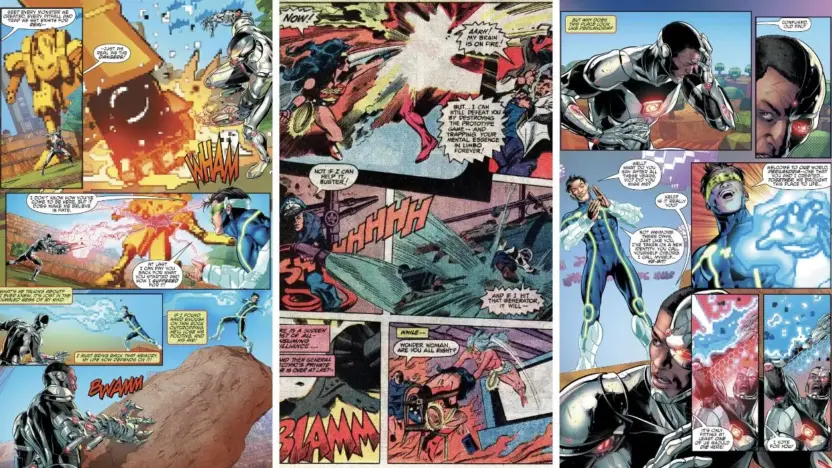Within the digital world of video games, DC superheroes have encountered scenarios that transcend the boundaries of their traditional comic book narratives. From Batman’s reality-warping adventures in Gotham to Wonder Woman’s virtual showdown against a telepathic menace, these instances highlight the innovative blending of mediums. The Flash’s retro digital trap, Jimmy Olsen’s unexpected foray into a video game world, and Cyborg’s nostalgic journey through a childhood creation all illustrate the unique challenges and storytelling possibilities that arise when superheroes find themselves navigating the pixelated landscapes of video games. This 5 Instances When DC Superheroes Found Themselves Trapped Within Video Games offers fans thrilling new adventures.
5 Instances When DC Superheroes Found Themselves Trapped Within Video Games
Batman’s Ingenious Spin on the Video Game Dilemma
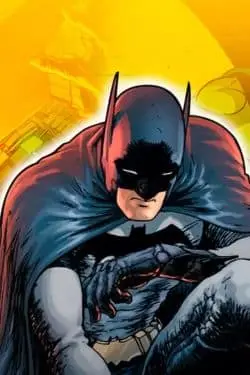
In an enthralling narrative spanning three issues of Detective Comics #635-637 from 1991, crafted by the talents of Louise Simonson, Jim Fern, and Steve Mitchell, we’re treated to an unconventional twist in the superhero genre. Instead of the cliché plot where characters are sucked into a video game, the story introduces us to a devious scientist at Arkham Asylum. This villain exploits a young boy’s extraordinary abilities to morph reality itself into a living, breathing video game, transforming Gotham into a perilous digital landscape.
This innovative take blurs the lines between reality and the digital world in a way that challenges the traditional video game trope. Here, Batman doesn’t find himself trapped inside a video game in the usual sense. Instead, reality around him is twisted into a video game format, turning the Bat-Cave and, eventually, Arkham Asylum itself into stages of a game, complete with challenges and enemies drawn from Batman’s notorious rogues gallery.
The storyline cleverly utilizes Robin’s familiarity with the video game being emulated by reality, allowing him to guide Batman through the game-like challenges. This partnership highlights the duo’s dynamic and resourcefulness in facing unconventional threats. The climax unfolds with a dramatic transformation of Arkham Asylum into a game level, where Batman must navigate through the digital avatars of his most formidable adversaries.
Wonder Woman vs. The Digital Menace: A High-Stakes Virtual Showdown!

In an extraordinary tale from the archives, the 1982 Wonder Woman #296 issue, penned by the talented Roy Thomas and Dan Mishkin, with the artistry of Gene Colan and Frank McLaughlin, presents an unusual adversary for our beloved Amazonian princess—General Electric. No, not the corporation, but a formidable telepathic villain bearing the same name. General Electric concocts a sinister video game, Commander Video, which not only ensnares players within its digital clutches but also enables him to infiltrate their minds.
The plot thickens when Wonder Woman, in her valiant effort to thwart General Electric’s nefarious plans, finds herself trapped within the pixelated confines of the game. Battling against digital dangers and the villainous Commander Video, she faces the looming threat of being permanently stuck in the virtual world. It’s a race against time and circuitry until Steve Trevor, in a heroic feat of his own, intervenes. By sabotaging the game’s power source, Trevor becomes the unsung hero, ensuring Wonder Woman’s triumphant return to reality.
The Flash’s Bizarre Adventure: A Pixelated Prison
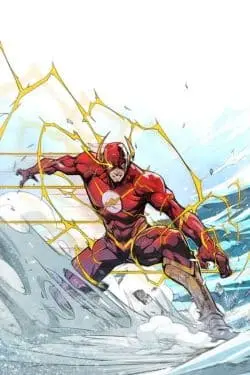
The quirky allure of video games was something not lost on the comic book world, as evidenced by tales like the Thing taking on aliens who inspired a game akin to Pac-Man. But it’s the 1981 issue of The Flash #304, penned by Cary Bates with art by Carmine Infantino and Bob Smith, that truly dives headfirst into the concept with a twist that’s as retro as it is fascinating.
Enter Colonel Computron, a character with a bone to pick. This new villain, an embittered employee of a toy company, concocts a plan steeped in digital revenge. His target? His boss, whom he aims to trap and eliminate within the confines of a video game. The twist? The Flash, ever the hero, intervenes and becomes the unintended victim of Computron’s digital trap.
Trapped in the pixelated world, The Flash experiences a surreal moment reminiscent of his Silver Age escapades, feeling as though he’s become nothing more than a puppet in someone else’s game. Tossed around by the simplistic yet unforgiving video game logic of the early ’80s, The Flash’s struggle to break free is a humorous nod to the era’s nascent gaming technology.
Jimmy Olsen’s Digital Misadventure
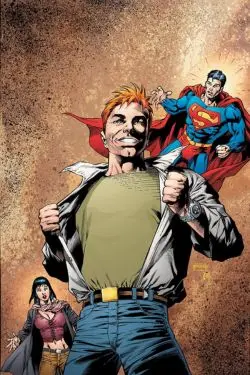
In the 2001 comic, Adventures of Superman #592, crafted by the creative team of Joe Casey, Mike Wieringo, and Jose Marzan Jr., we embark on a tale of unexpected digital chaos. Jimmy Olsen, Superman’s ever-curious friend, and Strange Visitor, a superhero grappling with her energy-based existence, find themselves thrust into the pixelated world of Jimmy’s video game.
This occurs when Strange Visitor loses control of her powers, sparking a teleportation mishap. Inside the game, Strange Visitor faces a crisis of confidence, overwhelmed by her perceived shortcomings as a hero, and leaves Jimmy to fend for himself in this virtual landscape. In a twist of fate, Superman intervenes, resetting the game and ensuring Jimmy’s safe return to reality. This adventure takes a somber turn as Strange Visitor later sacrifices herself in the battle against Imperiex, marking a heroic end to her troubled journey.
Cyborg’s Retro Gaming Adventure: Nostalgia with a Digital Twist
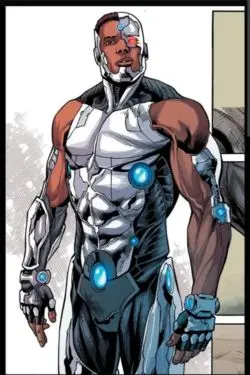
In a thrilling 2017 storyline from Cyborg #11, crafted by the creative minds of John Semper Jr., Will Conrad, Tom Derenick, Tony Kordos, Ivan Nunes, and Guy Major, we’re transported alongside Cyborg on an extraordinary journey through the cosmos. Utilizing the advanced Boom Tube technology in his quest to return to Earth and assist his father, Cyborg unexpectedly finds himself in a realm far removed from the physical universe. This digital domain, a nostalgic homage to a childhood pastime, emerges from the memories he no longer recalls.
This virtual world is the brainchild of an old friend from Victor Stone’s youth, Keiji, now adopting the moniker H8-Bit. This digital universe draws inspiration from a video game the duo had once created during their formative years at computer camp. The reunion, however, is far from warm. Cyborg learns of a buried past, where a youthful prank — granting Keiji unauthorized access to S.T.A.R. Labs’ systems — led to dire consequences for Keiji, culminating in a life marred by hacking and eventual incarceration.
The narrative takes a darker turn as Cyborg discovers the painful truth: the Keiji he interacts with in this digital realm is the only vestige of his friend that remains. The real Keiji’s life was tragically cut short, a victim of brutality within the confines of a juvenile detention center. This revelation comes only after Cyborg, relying on a glitch from their childhood game, defeats the virtual challenge laid before him, crashing the game in a bittersweet triumph.
Also Read: Ranking Every Love Interest of Wonder Woman in the Comics
